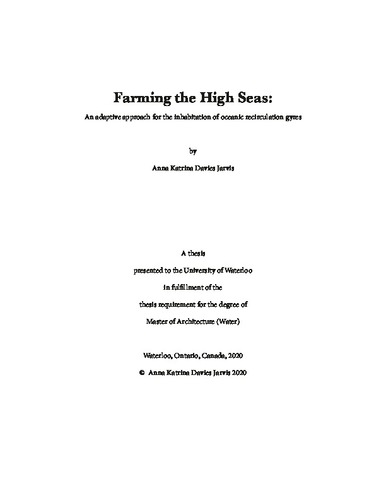| dc.contributor.author | Jarvis, Anna Katrina Davies | |
| dc.date.accessioned | 2020-05-29 18:39:57 (GMT) | |
| dc.date.available | 2020-05-29 18:39:57 (GMT) | |
| dc.date.issued | 2020-05-29 | |
| dc.date.submitted | 2020-05-17 | |
| dc.identifier.uri | http://hdl.handle.net/10012/15957 | |
| dc.description.abstract | Ocean management authorities predict that global fish stocks will be severely depleted by mid-century
unless commercial fishing practices are greatly modified. This thesis considers aquatic
architecture in general, and explores in particular an experimental design for floating colonies
that follow oceanic circulation gyres for the development and management of high sea fisheries.
Because these colonies would be isolated from other human communities for much of the time,
they would need to be capable of being self-sustaining. The colonies could provide all of their own
power, shelter, food and water, but they have been designed to generate a surplus of energy and
protein. In the interest of diversifying the resources available to their inhabitants and reducing
pressure on wild fish stocks and non-renewable energy sources, the colonies could trade fish and
power with coastal nations as they travel around the gyres. Geopolitical ramifications of High
Seas inhabitation are also considered.
A range of books, journals, websites and documentaries were studied in order to gain a broad
understanding of the historical, ecological, and political context of drifting High Seas resource
and research stations. The design of the structures presented is informed by environmental
factors such as wavelengths in stormy weather, psychological and physiological concerns such as
isolation from society, exposure to an extreme and highly changeable environment, fish behaviour
and nutritional requirements of aquatic species at various trophic levels. The location of the
project has been chosen based on current and historical environmental and political conditions
such as fish migration patterns and the slow rate of change for international law. | en |
| dc.language.iso | en | en |
| dc.publisher | University of Waterloo | en |
| dc.subject | architecture | en |
| dc.subject | aquatic architecture | en |
| dc.subject | sustainability | en |
| dc.subject | fisheries | en |
| dc.subject | aquaculture | en |
| dc.subject | High Seas | en |
| dc.subject | Atlantic ocean | en |
| dc.subject | oceanic gyres | en |
| dc.title | Farming the High Seas: An adaptive approach for the inhabitation of oceanic recirculation gyres | en |
| dc.type | Master Thesis | en |
| dc.pending | false | |
| uws-etd.degree.department | School of Architecture | en |
| uws-etd.degree.discipline | Architecture | en |
| uws-etd.degree.grantor | University of Waterloo | en |
| uws-etd.degree | Master of Architecture | en |
| uws.contributor.advisor | English, Elizabeth | |
| uws.contributor.affiliation1 | Faculty of Engineering | en |
| uws.published.city | Waterloo | en |
| uws.published.country | Canada | en |
| uws.published.province | Ontario | en |
| uws.typeOfResource | Text | en |
| uws.peerReviewStatus | Unreviewed | en |
| uws.scholarLevel | Graduate | en |

